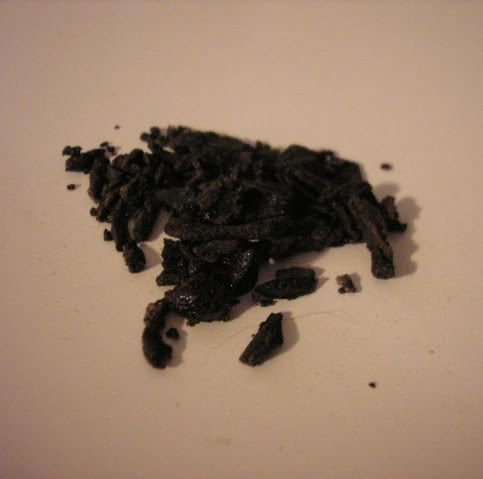
 |
|
|
|
|
#1 |
|
Member
Join Date: Dec 2004
Location: What is still UK
Posts: 5,923
|
Many Indian and other Asian weapons have the tang set in a grainy plaster/cement like compound. In trying to repair a choora hilt I found the tang held with this substance which hand become very crumbly.
This substance is like a fine lime mortar. Lime mortar in ancient. Last edited by Tim Simmons; 20th March 2011 at 09:59 AM. |
|
|

|
|
|
#2 |
|
Member
Join Date: Jun 2006
Location: ca, usa
Posts: 92
|
Ok, So Damar is just pine pitch glue (Damar Pine) with some combination of charcoal, beeswax, and some other hardening/bonding agent (clay,fiber,etc). That's been helpful reading, thanks. So if I understand this right, Damar and the European cutler's resin were relatively the same in so far as they are all pine pitch glues?
I found the whole process to make pitch glue nicely outlined here: http://www.survivaltopics.com/surviv...ng-pitch-glue/ |
|
|

|
|
|
#3 | |
|
Member
Join Date: Dec 2004
Posts: 1,712
|
Quote:
The Laha I saw used used in Dharan Nepal in 2005 was boiled tree resins,saps & tars mixed with hard powderd or ground substances like stone, bone & buffalo horn dust etc. untill it is of the right quality & consitancy. Occasionaly its dark brown mostly its black. I expect many different handy ingriediants have been chucked into it over the years. spiral |
|
|
|

|
|
|
#4 |
|
(deceased)
Join Date: Dec 2004
Location: OKLAHOMA, USA
Posts: 3,138
|
THE SAME PITCH USED TO CAULK CRACKS, PROTECT ROPES AND GEAR FROM MOISTURE ON SAILING SHIPS IS OFTEN USED TO WATERPROOF AND SECURE BLADES AS WELL AS WOVEN CORDS ON WEAPONS. NATIVE AMERICANS USED NATURALLY OCCURRING PETROLEUM FOUND IN SEEPS ON ROCK FACES OR POOLS OR TAR BALLS FROM BEACHES. ASPHALT OCCURS NATURALLY IN QUITE A FEW PLACES AND WOULD HAVE BEEN AVAILABLE AND YIELD GOOD ADHESIVES. THE LABEREA TAR PITS IN CALIFORNIA AS WELL AS OTHER SEEPS COME TO MIND AND NO DOUBT WERE TO BE FOUND HERE AND THERE. IT WORKED WELL FOR SEALING BASKETS TO HOLD LIQUIDS AS WELL AS TO SECURE POINTS OR WATERPROOF GEAR. NO DOUBT THESE NATURALLY OCCURRING SEEPS WERE AVAILABLE IN MANY AREAS AND PROCESSED AND USED FOR MANY THINGS BY MANY SOCIETY'S.
I BELIEVE THE SAP (RAW LATEX) FROM THE RUBBER TREES WERE PROBABLY PROCESSED AND USED FOR SIMILAR PURPOSES. THERE WOULD BE MINERAL , VEGETABLE AND ANIMAL ADHESIVES AND GLUES FROM MANY SOURCES USED. PERHAPS SOMEONE FROM AUSTRALIA COULD ENLIGHTEN US ON THE PREPARATION OF SPINIFEX GRASS AND GUM TREE RESINS USED BY THE ABORIGINALS. ADHESIVES THAT WERE WATERPROOF SEEM TO BE PREFERRED ESPECIALLY ON WEAPONS OR TOOLS THAT WOULD SEE A LOT OF USE. I HAVE DUG UP LUMPS OF BLACK ADHESIVE IN OLD INDIAN CAMPS SEVERAL HUNDRED YEARS OLD. I HAVEN'T TESTED THEM BUT SUSPECT THEY ARE NATURAL PETROLEUM/TARS WHICH ARE HIGH IN PARAFFIN AND WATERPROOF. Last edited by VANDOO; 22nd March 2011 at 04:36 AM. |
|
|

|
|
|
#5 |
|
Member
Join Date: Oct 2008
Location: Manila, Phils.
Posts: 1,042
|
In western Visayas particularly in Panay, the sap from the breadfruit tree (local name is kamansi) is traditionally used as blade tang adhesive.
From a Hiligaynon-English dictionary: kalólot, To apply any sticky, viscous material. Ginakalólot sa ápal sang binángon ang tagók sang kamánsi. The juice of the bread-fruit is used for fastening the handle of a bolo.I think in Moroland, I think a tree sap called galgal is used. Spunjer would know this better. |
|
|

|
|
|
#6 | |
|
Member
Join Date: Jan 2007
Posts: 238
|
Quote:
  I read some articles about what might be used on mandau: nyatu/nyatoh and sambun, some mention getah merah and getah putih which might relate but I can't tell how they differ. Attached is gum/resin product from Indonesian forestry dept. website. |
|
|
|

|
|
|
#7 |
|
Member
Join Date: Oct 2007
Posts: 2,818
|
This is great stuff guys, Pandora's box has been opened.....
Thanks heaps for the efforts. Gav |
|
|

|
|
|
#8 | |
|
Member
Join Date: Jan 2007
Location: The Netherlands
Posts: 1,462
|
Quote:
|
|
|
|

|
|
|
#9 | |
|
Member
Join Date: Jan 2007
Posts: 238
|
Quote:
 . .I would like to add: this could be the one used for keris/pedang hilt core which incorporated silver wrapping. Last edited by tunggulametung; 22nd March 2011 at 01:34 PM. |
|
|
|

|
|
|
#10 | |
|
Member
Join Date: Oct 2008
Location: Manila, Phils.
Posts: 1,042
|
Quote:
Closely related to what we call kamansi would be rimas, which in Malaysia or Indonesia is sukun. Additional info is here and here. Perhaps the sap of rimas/sukun will also do the job. By the way, getah in your language is gata in ours, and they mean the same thing. 
|
|
|
|

|
|
|
#11 |
|
Member
Join Date: Dec 2004
Location: Witness Protection Program
Posts: 1,730
|
yep, galgal is indeed used, but i'm not sure if that's the colloquial term for sap, or the name of the tree itself.
incidentally, i'm working on a kris right now that somehow the tang of the blade is protruding from the handle; i believe the wood shrunk and eventually pushed it out. fortunately, i was able to salvage the galgal, first time i've done that, so i could actually refit the blade using the original resin. here's the picture of the galgal: 
|
|
|

|
 |
| Thread Tools | Search this Thread |
| Display Modes | |
|
|